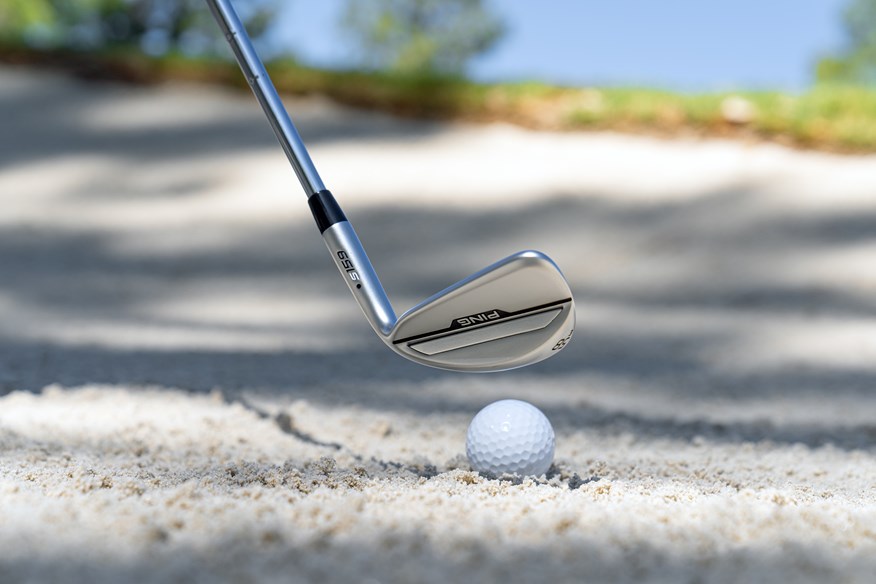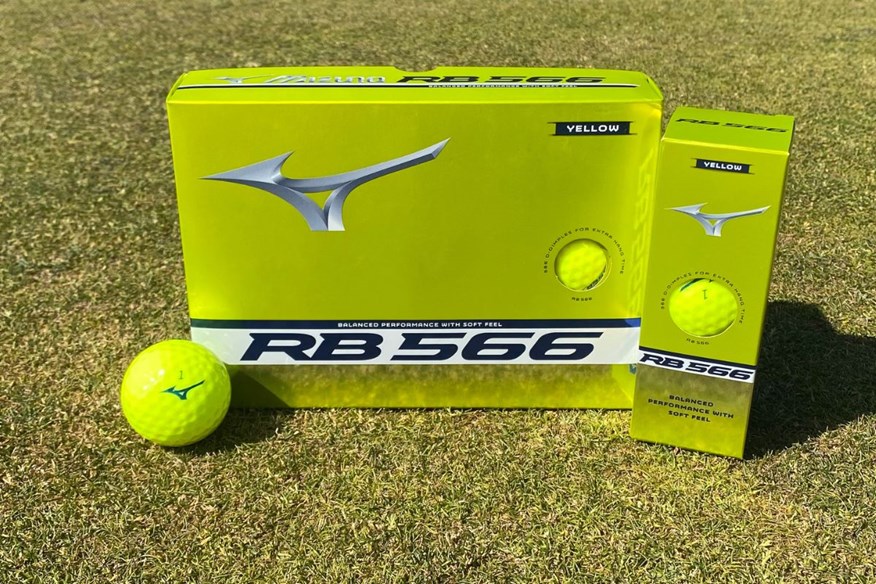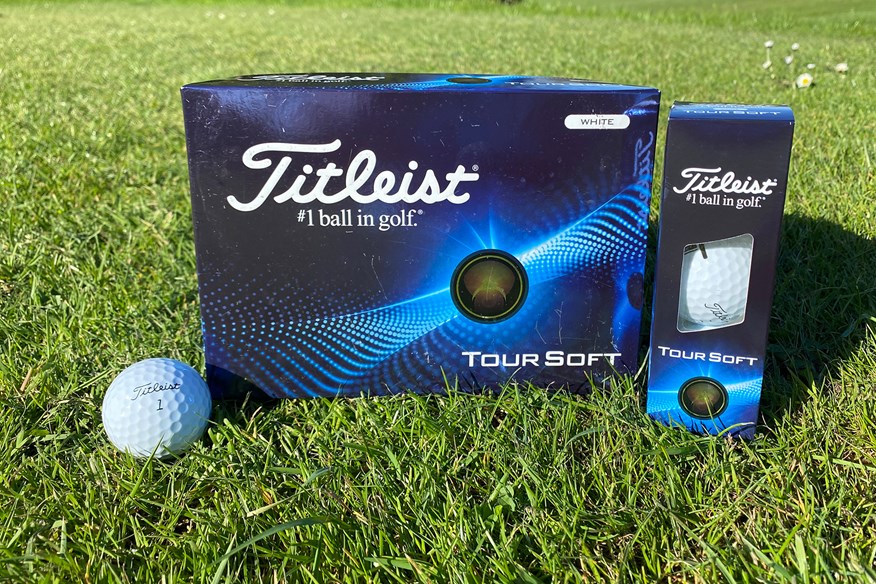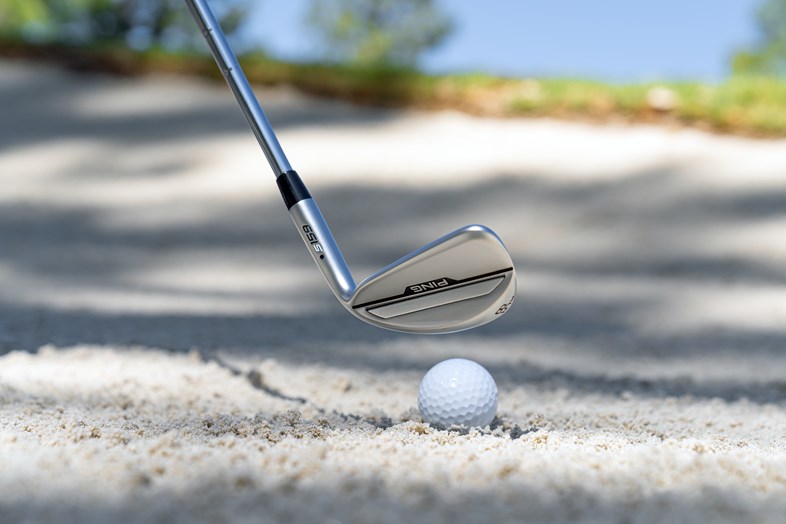
Our robot test reveals whether you need a urethane golf ball to increase or maintain spin.
Spin is your friend, and I’ll keep banging that drum until everyone receives the message.
But does it mean you have to play with one of the best premium urethane golf balls to generate high spin? You know the drill by now: we tested 62 golf balls in our 2025 robot test to find out.
Most golfers will benefit from playing with one of the best high-spin golf balls over the best low-spin golf balls because it’s going to help your ball flight, stopping powers, and short game control.
So, with that being said, are high-spin balls exclusive to premium urethane models, or can non-urethane, two-piece golf balls keep up with the big guns?
How we tested the golf balls
To find out, we tested 62 different golf balls on a $100,000 swing robot. This machine delivers exactly the same strike every time, which means the only variable in our test was the ball itself.
We tested every ball in two areas where high-spin matters most:
7-iron – 80mph, which is club golfer average
56° wedge – hitting a 40-yard pitch shot
Here’s what the numbers revealed…
Which golf ball is going to give you the most spin?
Perhaps unsurprisingly, the golf ball that’s going to give you the most spin sports a urethane cover. The Callaway Chrome Tour X is the best high-spin golf ball. With the 40-yard pitch shot, the Chrome Tour X generated 6,343rpm – over 200rpm more than the second-highest-spinning model. And, with the 7-iron shot, it produced the most spin (5,242rpm), nearly 100rpm more than the second-most spinning ball.
Gold medal for approach play and short game performance
Best overall golf ball for short game
Robot test verdict
Every golfer wants a golf ball that stops on a dime when playing around the greens because it makes getting up and down so much easier. The golf ball that’s going to help you out most around the greens is the Callaway Chrome Tour X.
Of all 62 golf balls tested, the Chrome Tour X is the highest-spinning golf ball around the green. This golf ball was able to generate 6,343rpm, the nearest in this category is the TaylorMade TP5 (6,100), and the second-highest spinning in the test is the Srixon Z-Star Diamond (6,137).
The high-spin nature of the Chrome Tour X does continue through the bag, which isn’t an issue when approaching greens. As well as being awarded the gold medal for short game performance, the Chrome Tour X also finished first for approach play.
With the 7-iron shot, this is the highest-spinning golf ball in the test with 5,242rpm. Over 400 revs higher than the second-highest-spinning golf ball in this category (TaylorMade TP5 – 4,823).
The only issue with such a high-spinning golf ball is it hinders distance, so if you prioritise distance over spin, the Chrome Tour is a better option. However, if you want more control and spin, the Chrome Tour X has to be at the top of your list.
Off the tee, you aren’t losing much distance with the Chrome Tour X, and at 93mph, this is the second-best four-piece and five-piece golf ball from tee to green.
On-course verdict
Callaway have absolutely smashed it out of the park this year with their four-piece Chrome Tour, Chrome Tour X, and Chrome Tour Triple Diamond golf balls.
Other than having major shelf appeal, the Chrome Tour X is premium for multiple reasons. One of which is that it’s widely used by Tour players, and another is that it’s a really solid performer from tee to green.
Off the tee, the Chrome Tour X is the highest-spinning Chrome Tour model, which won’t be to everyone’s liking, but for those who struggle to generate height and potentially lose the ball left, then the Chrome Tour X is well worth considering.
The Chrome Tour X spins on command. Playing into and around greens is extremely fun and simple because you can throw this ball at the pin and it will stop.
If you want a golf ball that spins high and is easy to control, there isn’t a better option out there.
Read our full Callaway Chrome Tour X golf ball review.
Pros & Cons Specs Features
Pros Extremely high spin and control when approaching the greensProduces brilliant ball speeds and distancePlayed by some of the best players in the world across numerous Tours Cons Callaway’s highest-spinning premium golf ball might not be what every golfer needs Carry distance (yds) Driver 114mph – 269.7 | Driver 93mph – 208.9 | Driver 78mph – 160.8 | 7-iron – 156.1 Ball speed (mph) Driver 114mph – 163.6 | Driver 93mph – 134.3 | Driver 78mph – 113 | 7-iron – 108.7 Backspin (rpm) Driver 114mph – 2,997 | Driver 93mph – 3,048 | Driver 78mph – 2,921 | 7-iron – 5,242 | Pitch – 6,343 Launch angle (°) Driver 114mph – 10.8 | Driver 93mph – 12.5 | Driver 78mph – 13.5 | 7-iron – 20.3 | Pitch – 29.5 Descent angle (°) Driver 114mph – 38.7 | Driver 93mph – 34 | Driver 78mph – 28.8 | 7-iron – 45.3 | Pitch – 34.4 Peak height (yds) Driver 114mph – 33.3 | Driver 93mph – 23.4 | Driver 78mph – 16 | 7-iron – 29.1 | Pitch – 6.3 Compression (psi) 111 Hyper fast soft coreSeamless Tour aeroHigh-performance Tour urethane soft cover332 dimples4-Piece constructionAvailable in white and yellowAlternative models include Triple Track, 360° Triple Track, TruTrack, and Limited Edition patterns
Although the Chrome Tour X is going to give you the most spin of all 62 we tested, it does come at a cost.
Non-urethane models are cheaper, and you might not lose as much spin as you think. So, which non-urethane models are suitable alternatives if you’re searching for spin?
High-spin non-urethane golf balls
There is a common misconception that all non-urethane golf balls don’t spin. While that holds true for certain non-urethane models designed to maximize distance, it’s not the case for every surlyn or ionomer ball.
The results from our 2025 robot test did kick up a couple of surprise packages, but a couple of the highest-spinning non-urethane golf balls were expected.
Let’s take a look at the results…
IronGolf ballBackspin (rpm)Backspin rankMizuno RB 5664,9474thTitleist Tour Soft4,77414thTaylorMade Distance+4,59627thMaxfli StraightFli4,53029th
The highest-spinning non-urethane model from the 7-iron shot is the Mizuno RB 566. The two-piece Mizuno ball is only 300rpm behind the four-piece Chrome Tour X, and it’s better than half price.
It might not be surprising to see the RB 566 and Tour Soft as the highest-spinning non-urethane models, but the other two models might come as a surprise to you.
The Distance+ is TaylorMade’s distance-oriented two-piece model, and the StraightFli’s straight flight technology is designed to reduce spin; however, both of them are high-spinning when playing into greens.
WedgeGolf ballBackspin (rpm)Backspin rankTitleist Tour Soft6,0756thVice Tour5,96714thCallaway Warbird Distance+5,96315thMizuno RB 5665,96017thBridgestone e12 Speed5,95119th
The Titleist Tour Soft and Mizuno RB 566 continue to be high-spinning around the greens, with the Tour Soft being the highest-spinning non-urethane model from the 40-yard pitch.
The three-piece Vice Tour is the second-highest-spinning model, and the Callaway Warbird Distance+ is thrown into the mix, despite being a distance-oriented model.
The RB 566 is the fourth-highest-spinning model, just ahead of the Bridgestone e12 Speed, which is the biggest surprise of our 2025 robot test.
Which non-urethane golf ball is going to give you the most spin?
Taking into account that most golfers will want spin when it comes to finding the green, and playing around them if they miss the green in regulation, the two best non-urethane golf balls for generating spin are the Titleist Tour Soft and Mizuno RB 566.
The Tour Soft is the most expensive two-piece golf ball, but it’s still considerably cheaper than the Chrome Tour X, and you’re giving up less than 500rpm with a 7-iron and 300rpm at the 40-yard pitch.
However, the RB 566 is arguably the preferred option because it’s less than half the price of the Chrome Tour X, and within 300rpm with a 7-iron and 400rpm at the 40-yard pitch.
Bronze medal for short game performance
Best overall non-urethane high-spin golf ball

The Mizuno RB 566 is a very unique golf ball because it has 566 dimples. This makes it the golf ball with the most dimples. With all 566 dimples, does it make this golf ball perform differently?
Probably not. However, it is the bronze medal winner for short game performance (5,960rpm). Although the dimple technology isn’t specifically designed to generate spin, the RB 566 is the highest-spinning golf ball in approach play (4,947), and it lands with the steepest descent angle (45.3°).
Off the tee is where the RB 566 should make the most impact by reducing spin. It’s below the test average for backspin at 93mph and 78mph, and bang on the average at 114mph. This makes it a very average performer for off-the-tee performance.
It might not be what Mizuno are going for, but I’d recommend the RB 566 for anyone looking for a high-spin golf ball. It’s definitely a unique golf ball, and for that reason, it is interesting. However, the RB 566 should only tempt you if you’re looking to add spin to your game.
On-course verdict
There’s something very exciting about a unique golf ball, and so that’s exactly how I felt when testing the Mizuno RB 566 with its 566 dimples.
I didn’t really know what to expect from this golf ball, but I definitely wasn’t expecting it to confuse me as much as it did. I had a lot of enjoyment playing with the RB 566 because I was able to throw the ball at the pin and watch it stop. I wasn’t expecting it to spin as much as it did.
This golf ball was high-spinning for me throughout the bag. Off the tee, I was struggling to stop the ball from spinning. I definitely had contrasting emotions off the tee to approaching the green.
The feel is soft, and it’s not the most responsive, which I’m not massively keen on.
Overall, I feel as though this is a high-spinning golf ball, almost to its detriment because it balloons off the tee. However, a different golfer might think otherwise, especially if you have a slower swing speed.
Pros & Cons Specs Features
Pros Great short-game spin and controlGood valueSolid performance from tee to green Cons Struggled to reduce spin off the tee on the course Carry distance (yds) Driver 114mph – 268.6 | Driver 93mph – 207.9 | Driver 78mph – 160.2 | 7-iron – 154.8 Ball speed (mph) Driver 114mph – 161.9 | Driver 93mph – 133.3 | Driver 78mph – 112.6 | 7-iron – 109.1 Backspin (rpm) Driver 114mph – 2,719 | Driver 93mph – 2,553 | Driver 78mph – 2,381 | 7-iron – 4,947 | Pitch – 5,960 Launch angle (°) Driver 114mph – 11.1 | Driver 93mph – 13 | Driver 78mph – 14.1 | 7-iron – 20.7 | Pitch – 30.6 Descent angle (°) Driver 114mph – 36.9 | Driver 93mph – 31.6 | Driver 78mph – 27.2 | 7-iron – 45.3 | Pitch – 36 Peak height (yds) Driver 114mph – 31.5 | Driver 93mph – 21.9 | Driver 78mph – 15.4 | 7-iron – 29.6 | Pitch – 7 Compression (psi) 92 Large soft compression coreMicro dimple designIonomer cover566 dimples2-Piece constructionAvailable in white, yellow, and orange
Gold medal for short game performance
Best two-piece golf ball for greenside spin

Rrp: £34.00
Price: £32.95
Had it not been for the Bridgestone e12 Speed, the Titleist Tour Soft might well have been named the best two-piece golf ball. The Tour Soft performed best in short game performance, finishing first, as the only two-piece golf ball to generate over 6,000rpm (6,075 – sixth overall and the highest-spinning Titleist model).
Moving to approach play, this golf ball is the bronze medal winner in this area. Tour Soft produces the second-highest spin (4,774rpm) and second-steepest descent angle (45.2°), but it is the shortest two-piece golf ball (154.2yds).
Off-the-tee performance has this golf ball very closely matched with Titleist’s distance two-piece golf ball – Velocity. Granted, Tour Soft is slightly shorter and slower at all three swing speeds. However, giving up less than a yard off the tee at every swing speed is probably worth it for the approach play and short game performance gains. It performed well enough at 114mph to earn the silver medal for tee to green performance.
Tour Soft is a super consistent golf ball in every area. If you’re looking for a two-piece golf ball that’ll do everything, this golf ball needs to be on your mind.
On-course verdict
This is one of the best-feeling golf balls I’ve had the pleasure of playing with purely because of how soft it is. I’m not always a fan of soft golf balls, but when they feel as good as the Tour Soft does, there’s nothing to dislike.
The feedback and response throughout the bag is exactly what you want with a soft golf ball, but it’s most enjoyable when playing around the greens because you can really feel the ball interacting with the grooves.
Around the greens, this ball generates amazing spin and control that’s capable of challenging the best high-spin golf balls.
Moving away from the green, I didn’t notice anything special about the Tour Soft’s performance, but in the same breath, there’s nothing to criticise. If anything, this ball performs better than you would expect from a two-piece model.
The Titleist Tour Soft is great value, and if you want a soft-feeling golf ball, this is the model you want.
Pros & Cons Specs Features
Pros Amazing short-game spin and controlIncredibly soft and responsiveGreat value Cons Short distance in iron play Carry distance (yds) Driver 114mph – 271.3 | Driver 93mph – 208.5 | Driver 78mph – 160.4 | 7-iron – 154.2 Ball speed (mph) Driver 114mph – 163.3 | Driver 93mph – 133.4 | Driver 78mph – 112.8 | 7-iron – 108.3 Backspin (rpm) Driver 114mph – 2,776 | Driver 93mph – 2,731 | Driver 78mph – 2,438 | 7-iron – 4,774 | Pitch – 6,075 Launch angle (°) Driver 114mph – 11.1 | Driver 93mph – 13 | Driver 78mph – 14 | 7-iron – 21.1 | Pitch – 30.4 Descent angle (°) Driver 114mph – 37.6 | Driver 93mph – 32.8 | Driver 78mph – 27.3 | 7-iron – 45.2 | Pitch – 35.7 Peak height (yds) Driver 114mph – 32.6 | Driver 93mph – 22.8 | Driver 78mph – 15.4 | 7-iron – 29.5 | Pitch – 6.8 Compression (psi) 95 Large, faster coreReformulated thin fusablend coverProprietary quadrilateral dipyramid dimple design346 dimples2-Piece constructionAvailable in white, green, and yellowAn alternative model is AIM 360 Conclusion: Urethane vs non-urethane
I’m not going to try to convince you that non-urethane golf balls are higher-spinning than urethane golf balls because, overall, that isn’t the case. However, some non-urethane balls do spin higher than urethane models. It’s all about finding the right option.
If you’re looking for optimal spin, it could be the case that you’re choosing between a urethane and a non-urethane golf ball. At that point, it then comes down to your other preferences, but you don’t need a urethane golf ball to generate spin.
About the author

He spent seven years working for American Golf as part of the sales and fitting team alongside his studies and is a specialist in putters, golf balls, and apparel.
James took up golf as a teenager and, thanks largely to his length and consistency off the tee, he plays off a handicap of 4.7 at Cleveland Golf Club.
You can contact James via email for loads more golf equipment insight.







